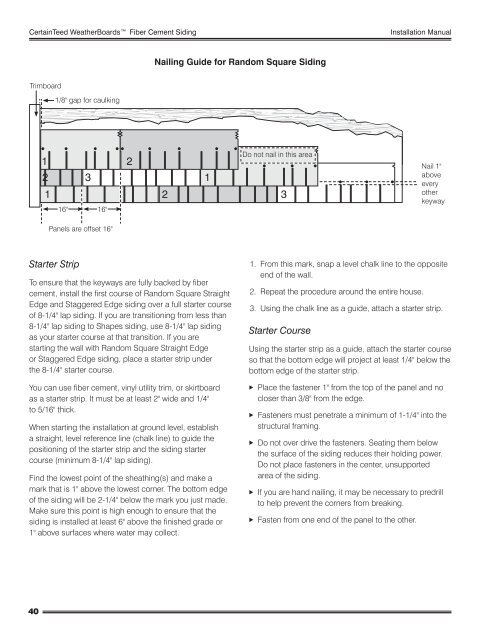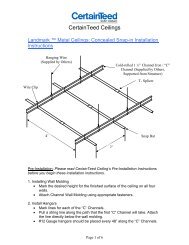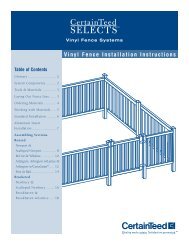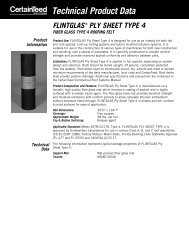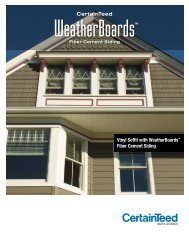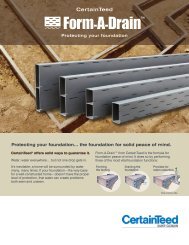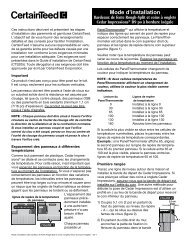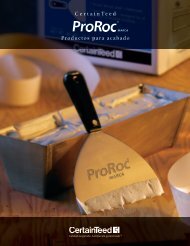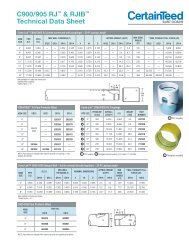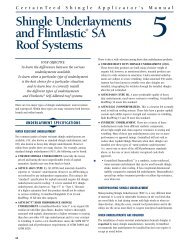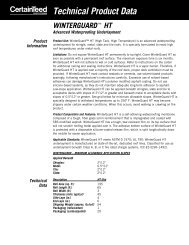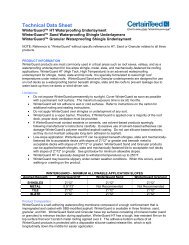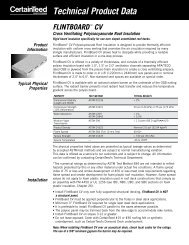Installation Manual - CertainTeed
Installation Manual - CertainTeed
Installation Manual - CertainTeed
You also want an ePaper? Increase the reach of your titles
YUMPU automatically turns print PDFs into web optimized ePapers that Google loves.
<strong>CertainTeed</strong> WeatherBoards Fiber Cement Siding <strong>Installation</strong> <strong>Manual</strong><br />
Trimboard<br />
Starter Strip<br />
To ensure that the keyways are fully backed by fiber<br />
cement, install the first course of Random Square Straight<br />
Edge and Staggered Edge siding over a full starter course<br />
of 8-1/4" lap siding. If you are transitioning from less than<br />
8-1/4" lap siding to Shapes siding, use 8-1/4" lap siding<br />
as your starter course at that transition. If you are<br />
starting the wall with Random Square Straight Edge<br />
or Staggered Edge siding, place a starter strip under<br />
the 8-1/4" starter course.<br />
You can use fiber cement, vinyl utility trim, or skirtboard<br />
as a starter strip. It must be at least 2" wide and 1/4"<br />
to 5/16" thick.<br />
When starting the installation at ground level, establish<br />
a straight, level reference line (chalk line) to guide the<br />
positioning of the starter strip and the siding starter<br />
course (minimum 8-1/4" lap siding).<br />
Find the lowest point of the sheathing(s) and make a<br />
mark that is 1" above the lowest corner. The bottom edge<br />
of the siding will be 2-1/4" below the mark you just made.<br />
Make sure this point is high enough to ensure that the<br />
siding is installed at least 6" above the finished grade or<br />
1" above surfaces where water may collect.<br />
40<br />
1<br />
2<br />
1<br />
1/8" gap for caulking<br />
16"<br />
3<br />
3<br />
16"<br />
Panels are offset 16"<br />
2<br />
Nailing Guide for Random Square Siding<br />
2<br />
1<br />
Do not nail in this area<br />
3<br />
3<br />
1. From this mark, snap a level chalk line to the opposite<br />
end of the wall.<br />
2. Repeat the procedure around the entire house.<br />
3. Using the chalk line as a guide, attach a starter strip.<br />
Starter Course<br />
Using the starter strip as a guide, attach the starter course<br />
so that the bottom edge will project at least 1/4" below the<br />
bottom edge of the starter strip.<br />
XXPlace the fastener 1" from the top of the panel and no<br />
closer than 3/8" from the edge.<br />
XXFasteners must penetrate a minimum of 1-1/4" into the<br />
structural framing.<br />
XXDo not over drive the fasteners. Seating them below<br />
the surface of the siding reduces their holding power.<br />
Do not place fasteners in the center, unsupported<br />
area of the siding.<br />
XXIf you are hand nailing, it may be necessary to predrill<br />
to help prevent the corners from breaking.<br />
XXFasten from one end of the panel to the other.<br />
Nail 1"<br />
above<br />
every<br />
other<br />
keyway


